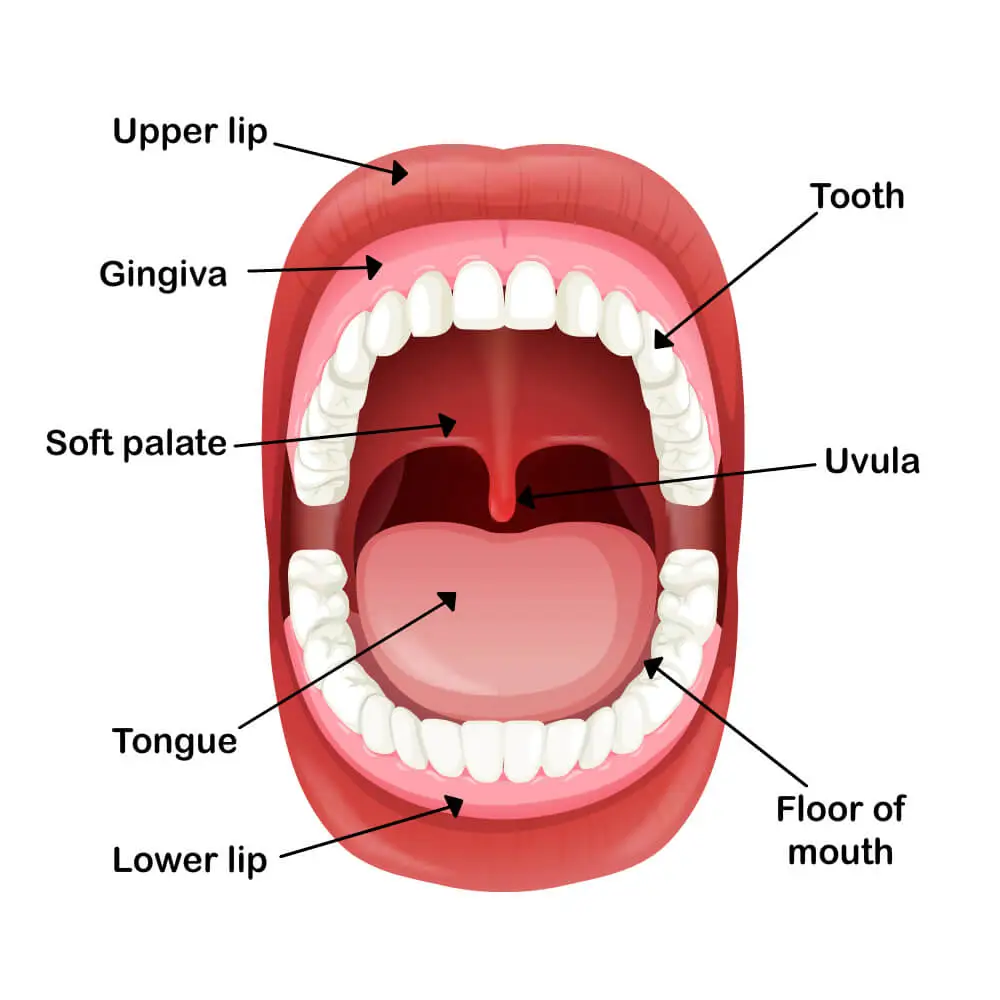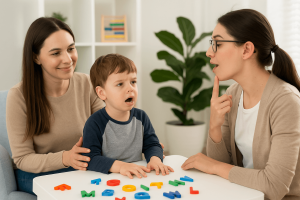Oral Motor Exercises: Improve Soft Palate Sensations
By Rajini D
Last Updated: November 18, 2023
Speech is a fundamental aspect of human connection. It facilitates social interaction, helps build relationships, and is crucial for various aspects of daily life, from education to work and personal relationships. Speech is essential for human communication, social interactions, and the expression of thoughts and emotions. To have a free flow of speech, all the parts of the mouth, including the control of airflow, contribute a lot. The soft palate or velum plays a crucial role in speech production by helping to control the airflow and resonance in the vocal tract.

When you speak, air from your lungs passes through the trachea and into the oral cavity. The soft palate can move to either close off the nasal cavity or open it up. The production of various speech sounds are an outcome of its regulation. Hence, it is important to focus on the function of the soft palate. Improving the sensations of the soft palate can increase the effectiveness of speech production. Strengthening the muscles and improving the function of the soft palate can contribute to improved speech articulation and overall oral motor control.
What is the role of soft palate in speech production?
To know about the exercises that contribute to the sensations of soft palate, it is necessary to understand the role of soft palate in speech production. Let us throw some light onto the areas where soft palate plays an important role.
Also Read: What is the Relation between Communication, Speech and Language? | Speech and Language Therapy
Nasal resonance:
The soft palate regulates the airflow between nasal and oral cavities during speech production. Practicing exercises that improve soft palate movements can help in improving the function of controlling nasal resonance, which is essential for producing nasal sounds like /m/, /n/, and /ng/. Strengthening the soft palate can lead to clearer and more accurate production of such nasal sounds.
Articulation:
Practicing soft palate exercises can enhance the articulation capabilities of an individual. These exercises focus on improving the production of sounds that require coordinated movement between the soft palate and other articulators. By strengthening the muscles of the soft palate, an individual can achieve better control over the movements of the soft palate, leading to a clearer articulation of speech sounds and words.
Speech clarity:
For improving the speech clarity and speech quality of an individual, taking care of the soft palate is necessary. Clear and precise articulation facilitated by a well-functioning soft palate can improve the intelligibility of speech. Such clarity can help others to easily understand and comprehend what is being said by an individual.
Read more on our article Understanding Speech Chain: Key to Better Communication
Air flow regulation:
The soft palate is involved in regulating the airflow during speech production. This airflow regulation helps in distinguishing between nasal sounds and oral sounds. The exercises that target the soft palate improve its ability to modulate airflow, which, in turn, would control the production of various speech sounds.
Overall communication skills:
Strengthening the soft palate fosters better speech production, articulation, and nasal resonance, which results in a positive impact on the overall communication skills of an individual. Improved soft palate function can result in effective communication. As a result, better interpersonal interactions take place, enhancing an individual’s performance in social, academic, and professional settings.
Soft Palate Exercises and Their Benefits
| Exercise | Description | Benefits |
|---|---|---|
| Sustained Humming | Humming a single note for as long as possible with the mouth closed. | Strengthens soft palate muscles, improves nasal resonance, and enhances vocal tone. |
| Controlled Yawning | Intentionally initiating a yawn to elevate the soft palate. | Increases soft palate flexibility and control promotes relaxation of throat muscles. |
| Nasal Airflow Control | Alternating breathing between the nose and mouth while focusing on airflow. | Improves awareness and control of airflow, essential for distinguishing nasal and oral sounds. |
| Blowing Exercises | Blowing through a straw into a glass of water or blowing up balloons. | It enhances control over breath and airflow, and strengthens muscles involved in speech production. |
| Gargling | Gargling water in the back of the throat for short periods. | Stimulates the soft palate and throat muscles, improving their agility and strength. |
| Vocalizing Nasal Consonants | Repeatedly vocalizing nasal sounds like /m/, /n/, /ng/ in various pitches. | Targets and strengthens the soft palate, enhancing the clarity of nasal sounds. |
Read more about Oral motor Exercises: Key to Better Speech.
How to improve the sensations of the soft palate?
The sensations of the soft palate are targeted for better speech development. Here are some techniques that can help an individual to improve the sensations of the soft palate or velum.
Know more about the Unlocking Communication: Effective Speech Therapy for Autism.
Velum elevation exercises:
The exercises that constantly elevate the soft palate, such as sustained Humming or vocalizing nasal consonants such as /m/, /n/, or /ng/, can be practiced to improve the sensations of the soft palate. Practicing these exercises would strengthen the muscles of the soft palate and improve the control over its movement during speech production.
Yawning exercises:
Yawning naturally involves the elevation of the soft palate. Imitation of yawning acts as an exercise; performing controlled yawning exercises can help increase muscle flexibility and promote better soft palate function.
Nasal airflow control:
Controlling the airflow through the nasal cavity and oral cavity is important in speech production. Practicing exercises to control this airflow is essential in speech development. Techniques such as alternating between breathing through the nasal cavity and mouth can help in the awareness of airflow. Practicing controlled nasal breathing can improve soft palate function. These exercises can regulate airflow during speech.
Articulation exercises:
Some specific articulation exercises, such as producing nasal sounds, involve the use of a soft palate. There are other articulation exercises that involve the coordination of the soft palate, tongue, and other articulators. All these exercises can help improve the sensations of the soft palate. Focusing on the accurate production of these sounds can help improve soft palate function and speech articulation.
Comparison of Speech Quality Before and After Soft Palate Strengthening
| Aspect of Speech | Before | After |
|---|---|---|
| Nasal Resonance | Nasal sounds may be unclear or excessively nasal due to poor airflow control. | Improved control over nasal airflow results in clearer, more natural nasal sounds. |
| Speech Clarity | Speech may be muffled or difficult to understand due to inadequate control of the soft palate. | Enhanced soft palate control leads to clearer, more distinct speech. |
| Articulation | Difficulty producing certain sounds accurately, leading to reduced intelligibility. | Strengthened soft palate muscles allow for precise articulation of sounds, improving speech intelligibility. |
| Breath Support | Inefficient use of breath during speech, potentially leading to weaker voice projection. | Better airflow regulation enhances breath support for stronger, more consistent voice projection. |
| Voice Quality | Voice may lack richness or resonance due to poor soft palate function. | Improved soft palate function enhances vocal tone, richness, and resonance. |
| Speech Endurance | Speaking for long periods may be tiring or result in vocal strain. | Strengthened soft palate and associated muscles increase speech endurance, reducing strain. |
Know more about Understanding the Role of Speech Therapists in Online Settings.
Speech therapy:
A Speech Language pathologist can provide targeted exercises and techniques that are tailored to improve soft palate function in individuals. A speech and language pathologist or a speech therapist is a professional trained to improve speech production. They can offer personalized guidance and support to address specific language needs. According to the individual’s needs, speech therapists incorporate specific exercises targeting the soft palate function to facilitate effective speech development.
During the speech therapy sessions, a speech-language pathologist helps individuals produce speech sounds correctly, considering the position of the soft palate for different sounds. They may employ custom-tailored strategies to address any speech concerns that are unique to each individual. Speech therapists provide regular therapy sessions to work on targeted goals. These specific and measurable goals are formulated by involving parents and caregivers. They employ a variety of exercises to improve speech production, language comprehension, and overall communication skills. Working with a trained speech therapist is always recommended to achieve better results.
Explore more on Understanding Speech Delay: Causes, Milestones, and Therapy.
Conclusion
Speech production, an essential facet of human communication, relies significantly on the functionality of the soft palate. This muscular flap plays a pivotal role in regulating airflow and resonance, which is essential for articulating clear and precise speech sounds. Exercises aimed at improving soft palate sensations—such as velum elevation exercises, yawning exercises, nasal airflow control, and articulation exercises—can enhance speech clarity, nasal resonance, and overall articulation capabilities. These practices not only contribute to the physical strengthening of the soft palate but also foster better control over its movements, leading to improved speech production and clarity. Speech therapy, guided by a Speech Language Pathologist, offers personalized strategies and exercises tailored to individual needs, emphasizing the importance of targeted interventions in enhancing soft palate function for effective speech development.
At WellnessHub, we understand the critical role of the soft palate in speech and overall communication skills. We advocate for a holistic approach that combines specific oral motor exercises with professional guidance from speech therapists to optimize soft palate function. By focusing on exercises that enhance soft palate sensations and seeking specialized support, individuals can achieve significant improvements in speech clarity, articulation, and overall communication abilities. This integrative approach not only aids in speech development but also boosts confidence and enriches interpersonal interactions, contributing to a higher quality of life and well-being.
Frequently Asked Questions:
1. What is the soft palate, and what does it do?
The soft palate is a muscular flap at the back of the mouth that separates the mouth from the nose. It helps control airflow and resonance during speech, swallowing, and breathing.
2. How does the soft palate help with speech production?
By opening and closing, the soft palate controls airflow between the mouth and nose, which is crucial for producing different speech sounds. It also affects the resonance of your voice, making it sound richer or clearer.
3. What are some exercises I can do to improve my soft palate function?
Exercises like sustained humming, controlled yawning, nasal airflow control, blowing exercises, gargling, and vocalizing nasal sounds can strengthen the soft palate and improve its control.
4. How often should I do these exercises?
The frequency depends on your individual needs and goals. Start with a few repetitions daily and gradually increase as tolerated. Consulting a speech therapist can help you create a personalized plan.
5. Will these exercises help me speak more clearly?
Yes, strengthening the soft palate can lead to improved articulation, nasal resonance, and overall speech clarity. However, individual results may vary, and consistency is key.
6. When should I consider seeing a speech therapist?
If you have concerns about your speech clarity, articulation, or nasal resonance, a speech therapist can assess your soft palate function and recommend targeted exercises and strategies.
7. What can a speech therapist do to help with soft palate dysfunction?
They can provide personalized exercises, teach you techniques to improve oral motor skills and offer strategies to compensate for any limitations you may have.
8. How long does speech therapy typically last?
The duration depends on your individual needs and progress. Regular sessions are crucial for optimal results.
9. What are some of the benefits of improving soft palate function?
Clearer speech, better articulation, improved nasal resonance, increased vocal stamina, and enhanced overall communication skills.
10. How can improved communication skills impact my life?
It can boost confidence, improve relationships, enhance academic and professional performance, and contribute to a higher quality of life.
About the Author:
Rajini, M.Sc., Speech-Language Pathologist (9+ years of experience)
Rajini is a passionate and dedicated Speech-Language Pathologist with over 9+ years of experience, specializing in both developmental speech and language disorders in children and rehabilitation in adults. Driven by a desire to empower each individual to find their voice, Rajini brings a wealth of experience and a warm, genuine approach to therapy.
Currently, at Wellness Hub, she thrives in a team environment that values innovation, compassion, and achieving results for their clients.
Connect with Rajini to learn more about how she can help you or your loved one find their voice.
Book your Free Consultation Today
Parent/Caregiver Info:
Client’s Details:
* Error Message








